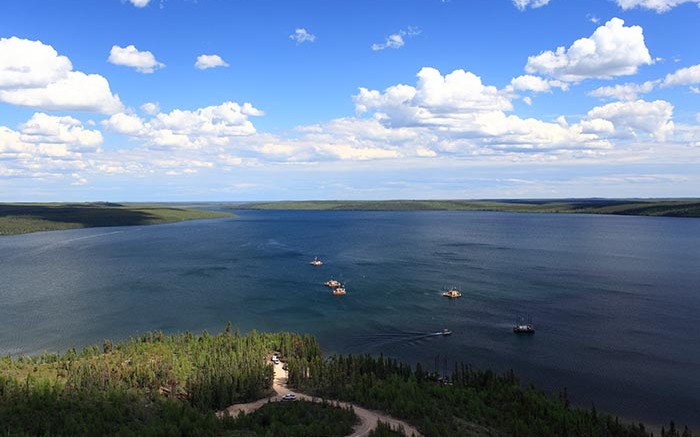Analysts are applauding Fission Uranium’s (TSX: FCU; US-OTC: FCUUF) preliminary economic assessment (PEA) on the Triple R deposit at its 100% owned Patterson Lake South property just outside the southwestern portion of Saskatchewan’s Athabasca basin.
The PEA, prepared by RPA Inc., estimates that a combined open-pit and underground operation at Triple R could produce 100.8 million lb. uranium oxide (U3O8) over 14 years.
The study shows “the viability and profitability of the project,” Cantor Fitzgerald analyst Rob Chang comments.
Roughly 76 million lb. with a 2.2% head grade would come from the pit and 25 million lb. with a 0.4% head grade from the underground mine using long-hole stoping. Open-pit mining could occur over the first six years, with underground mining starting in year four, Raymond James analyst David Sadowski writes.
Annual production rates would be 13 million lb. U3O8 in the first six years, and 3 million lb. U3O8 in the next eight years, to average 7.2 million lb. a year over the mine’s life.
That would make Triple R the “world’s fourth largest by production after the monstrous McArthur River, Cigar Lake and Husab operations,” Sadowski writes.
The cost to build Triple R is estimated at $1.1 billion, including $363 million for open-pit stripping and a dyke system to drain part of Patterson Lake, and $198 million for the processing plant. The total costs include a $208-million contingency and $189 million in sustaining capital costs.
Thanks to the high grade, estimated life-of-mine operating costs are only C$16.50 (US$14) per lb., which would put Triple R among the world’s lowest-cost uranium mines.
The project has further impressive economics: Using a base-case US$65 per lb. uranium oxide price and a 10% discount rate, the post-tax net present value is $1 billion, with a 34.2% internal rate of return. Payback would occur within 1.7 years after tax.
Over its life, Triple R would generate $7 billion in net revenue.
Fission Uranium says the PEA does not include the recently discovered, high-grade R600W zone, which could expand the resource and further improve economics.
Triple R’s indicated resource stands at 2.3 million tonnes grading 1.6% U3O8 for 80 million contained lb., including a high-grade zone of 44.3 million lb. based on 110,000 tonnes at 18.2% U3O8.
Inferred resources are 901,000 tonnes grading 1.3% U3O8 for 26 million contained lb., including a high-grade 13.9 million lb. based on 24,000 tonnes at 26.4% U3O8.
Most of the resource, including the high grade, is in the deposit’s eastern R780E zones, with the rest in the much smaller R00E zone to the west.
The zones have a combined 1.2-km strike length, with R780E measuring 900 metres and R00E at 125 metres. There’s a 225-metre gap between the zones, but drilling suggests there could be significant mineralization there.
The R00E zone sits partly on land, while the R780E zones are completely underneath Patterson Lake. “In order to access ore, part of the lake must be bermed-off and drained,” Sadowski says, adding that while it sounds “challenging,” several other open-pit projects in Canada have used dyke systems, including the Diavik diamond mine and the Meadowbank gold mine.
Given that all the current uranium operations in the Athabasca basin are underground mines, Chang says he is “concerned with permitting, as high-grade uranium dust control in an open-pit mine may be challenging.”
He says the firm will work on the project until 2017, with permitting wrapping up in 2024, followed by three years of development, and first production by 2028.
While the PEA didn’t suggest a start-up date, Fission’s management suggests the project’s permitting could wrap up by 2019, followed by three years of construction, and a possible 2022 start date, Sadowski says. Fission Uranium did not return a request for comment at press time.
The project’s development timeline will likely benefit from the company’s merger with uranium miner Denison Mines (TSX: DML; NYSE-MKT: DNN). The deal, announced in July, should get regulatory and shareholder approvals in October.
Given the strong PEA, Chang suggests Fission shareholders may wonder why the merger wasn’t done afterwards.
Chang has upgraded his rating from “hold” to “buy,” with a $1.60 target. Sadowski has changed his recommendation from “market perform” to “outperform,” with a $1.30 target.


Be the first to comment on "Fission Uranium’s Triple R shows strong economics"